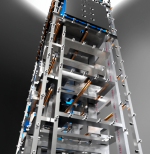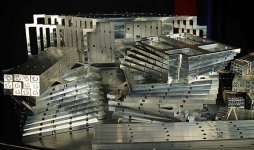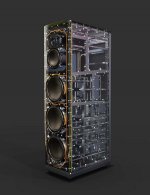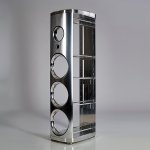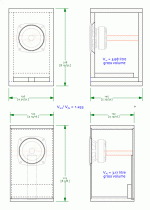Hello all. I am brand new to this forum, so please bear with me. I am also a beginner in the field of loudspeaker design and construction and am looking for help / feedback about ideas I have to design and build my own speakers. I am a Journeyman Machinist, and I understand the qualities and metallurgy regarding aluminium. I would like to incorporate my abilities to construct a loudspeaker enclosure made out of aluminium and educate myself as to how to effectively design a speaker accordingly. I have a general understanding about crossover design and requirements, as well as an appreciation of what has appealed to me over the years with different sounds systems and speaker types. I am looking to design and build a three way loudspeaker utilizing JBL drivers exclusively. Where would a person start when deciding on the size and type of driver for each frequency range and how would I approach the task of building a crossover? Do I design and build an enclosure first, and work from there? I understand this may be a lofty goal and there are a tremendous amount of variables that need to be addressed, however, "you don't know until you ask" has always been one of my philosophies. Any help will be greatly appreciated 
Where to start
Obtain the parameters of the speaker you wish to use.
Obtain some speaker enclosure software...Boxplot, Woofer Box and Circuit Designer 5.xls are a couple that come to mind...there are others.
Use the SW until you are comfortable with it...trying other speakers as well.
Enjoy the journey.

Obtain the parameters of the speaker you wish to use.
Obtain some speaker enclosure software...Boxplot, Woofer Box and Circuit Designer 5.xls are a couple that come to mind...there are others.
Use the SW until you are comfortable with it...trying other speakers as well.
Enjoy the journey.
Hi KLS,
You are looking at a lot of work, in multiple different dimensions. I'd suggest you tackle one or the other first. You don't become a doctor by studying every subject, the same is true for speaker building.
So, my suggestion is either learn how to design a simple 2 way first, or get a pre-designed 2-way and work out how to make a cabinet for it out of aluminum. If you want to go that way, my LM-1 design is free and online.
It uses the smallest Dayton cabinet of 0.25 ft3, so it would be ideal in terms of materials cost. As for design ideas, you might want to look at pics for modern Magico's. They use a combination of techniques. For the "low" end they use extruded aluminum tubes, with machined front baffle, while the high-end uses heavy duty internal bracing and very large pieces machined from aluminum billet.
You could for instance, build the kit as-is and then machine the front baffles. That is actually kind of an ideal place to start with aluminum, and then work your way back into the cabinet.
Best of luck
Erik
You are looking at a lot of work, in multiple different dimensions. I'd suggest you tackle one or the other first. You don't become a doctor by studying every subject, the same is true for speaker building.
So, my suggestion is either learn how to design a simple 2 way first, or get a pre-designed 2-way and work out how to make a cabinet for it out of aluminum. If you want to go that way, my LM-1 design is free and online.
It uses the smallest Dayton cabinet of 0.25 ft3, so it would be ideal in terms of materials cost. As for design ideas, you might want to look at pics for modern Magico's. They use a combination of techniques. For the "low" end they use extruded aluminum tubes, with machined front baffle, while the high-end uses heavy duty internal bracing and very large pieces machined from aluminum billet.
You could for instance, build the kit as-is and then machine the front baffles. That is actually kind of an ideal place to start with aluminum, and then work your way back into the cabinet.
Best of luck
Erik
Forgot to point out. Designing a good 3-way system is twice the work of designing a good 2-way, so the latter is much easier.  If you MUST do a 3-way (and I don't know why) start with a pre-built design. Madisound, Meniscus, Parts-Express and Troels Gravesen's site can help you.
If you MUST do a 3-way (and I don't know why) start with a pre-built design. Madisound, Meniscus, Parts-Express and Troels Gravesen's site can help you.
Erik
Erik
You should focus your skills on one narrow area to begin with, relying on others' abilities for the rest, then broaden your efforts as you master that first area. If you know nothing or little about system design, copy an existing design using drivers you like (Why JBL exclusively? There are so many different brands and types of driver that you should not impose such limitations before you even begin.). Build that design as simply as possible (mdf? plywood? foam board? pine boards?). When you're satisfied you have the right design and drivers, THEN build the enclosure out of aluminum. There is no special quality of aluminum that will influence your preference more than the drivers and basic design, including the crossover.
To answer one of your questions, the crossover must be designed based on the drivers response while mounted in the enclosure. A mere "general understanding" of crossovers is not enough knowledge to design one on your own. It is terribly complex and easily muddled. Let someone else do that heavy lifting while you concentrate on the aluminum construction. You could build enclosures out of diamonds and use the best drivers in the world, but the speakers will sound like crap without a good crossover.
Peace,
Tom E
To answer one of your questions, the crossover must be designed based on the drivers response while mounted in the enclosure. A mere "general understanding" of crossovers is not enough knowledge to design one on your own. It is terribly complex and easily muddled. Let someone else do that heavy lifting while you concentrate on the aluminum construction. You could build enclosures out of diamonds and use the best drivers in the world, but the speakers will sound like crap without a good crossover.
Peace,
Tom E
KLS67,
The problems with a passive three-way are significant in getting a crossover that works.
While not also insignificant but has a better chance of achieving a good quality speaker is to go active using a digital crossover with class D amps following. The use of a proven box eases the burden too, knowing the drivers work together.
That said, I am looking forward to photos of the grand adventure.
The problems with a passive three-way are significant in getting a crossover that works.
While not also insignificant but has a better chance of achieving a good quality speaker is to go active using a digital crossover with class D amps following. The use of a proven box eases the burden too, knowing the drivers work together.
That said, I am looking forward to photos of the grand adventure.
Designing a good 3-way system is twice the work of designing a good 2-way, so the latter is much easier.
And a FR would be even simpler, allowing you to get a handle on the aluminum box.
I have an aluminum boxed project in the works, still need to decide on some of the detail. The 3-4mm Al makes for a significantly smaller box then with the 12mm ply we usually use -- it is for a 3" FR.
dave
I read in an old book from Julio Rueda (an Argentine expert in audio) that some decades back, there has been baffles made with concrete, and also with plumb (lead), no I don't believe why not to try with aluminium. In any case, to build a small test project, will confirm if it is viable or not.
Good job, and enjoy.
Good job, and enjoy.
I did try 8mm thick steel.
the problem is simple.
it has been welded, it acts like a homogenous material.witch it is.
the problem with that, is that is has a verry noticeable , and well defined rezonance.
when it gets excited its horrible.
full aluminium would be even worse i suspect.
concrete is made out of a mix of different density materials , so its less prone to that problem. lead was used to make it heavyer, it did dampen it a bit more.
wood is used a lot, and if you look at wood, its made out of eighter real wood, witch has different size fiebers so rezonation happens over a wider spectrum and is not cummulative, only via harmonics. or its made out of some form of wooden chip board, witch is a composite material allso made out of different materials and is made up from different shapes. so it allso spreads the rezonation.
for the "ideal" material you want something composing of different materials. So, a composit.
Best results where achieved by many with thinner, but more stiff walls, and more dampening both on the inside, and the outside.
i would suggest to use some verry stiff material for the walls, and have a verry heavy, thic carpentry work on the outside, and wall glued stuffing on the inside.
a nother thing to consider is the shape of the box. more accurately, the ratios.
while the golden ratio was considered to be "the best", if you just do a bit of math, and do any box with golden ratio, and you start to calculate the harmonics of rezonations, you will see it willhappen after a few orders. witch is not so good, as then it will be cummulative.
instead try the third root of 2. now that is a different kind of animal.
allso, studio monitors do offer a transparent flat response, but that is all they do.
they are not that musical. they are good for studio work, but listening to music may not be that good..
it really depends on taste. i for one dislike flat response from a speaker.
the muical experience is simply dull.
so you have quite a lot of options, and even today we can get some extremely good cheap drivers. there is no sutch thing that X speaker is unbeatable by DIY.
specially if we take personal preference into account and subjectivity.
and we simply can not get away without it.
we are all different, preception does varry with people.
our biology is allso different.
the problem is simple.
it has been welded, it acts like a homogenous material.witch it is.
the problem with that, is that is has a verry noticeable , and well defined rezonance.
when it gets excited its horrible.
full aluminium would be even worse i suspect.
concrete is made out of a mix of different density materials , so its less prone to that problem. lead was used to make it heavyer, it did dampen it a bit more.
wood is used a lot, and if you look at wood, its made out of eighter real wood, witch has different size fiebers so rezonation happens over a wider spectrum and is not cummulative, only via harmonics. or its made out of some form of wooden chip board, witch is a composite material allso made out of different materials and is made up from different shapes. so it allso spreads the rezonation.
for the "ideal" material you want something composing of different materials. So, a composit.
Best results where achieved by many with thinner, but more stiff walls, and more dampening both on the inside, and the outside.
i would suggest to use some verry stiff material for the walls, and have a verry heavy, thic carpentry work on the outside, and wall glued stuffing on the inside.
a nother thing to consider is the shape of the box. more accurately, the ratios.
while the golden ratio was considered to be "the best", if you just do a bit of math, and do any box with golden ratio, and you start to calculate the harmonics of rezonations, you will see it willhappen after a few orders. witch is not so good, as then it will be cummulative.
instead try the third root of 2. now that is a different kind of animal.
allso, studio monitors do offer a transparent flat response, but that is all they do.
they are not that musical. they are good for studio work, but listening to music may not be that good..
it really depends on taste. i for one dislike flat response from a speaker.
the muical experience is simply dull.
so you have quite a lot of options, and even today we can get some extremely good cheap drivers. there is no sutch thing that X speaker is unbeatable by DIY.
specially if we take personal preference into account and subjectivity.
and we simply can not get away without it.
we are all different, preception does varry with people.
our biology is allso different.
To give an idea about the Magico enclosure:

This is the Q5 internal structure

A couple of Q5 parts...


They also have a bigger Q7: Magico Loudspeakers | Q7 Mk II
Crazy huh? I wonder how many bolts and pieces are in there...
I wonder how many bolts and pieces are in there...
Do not start with the enclosure, the drivers you choose determine the enclosure type and size etc...
Aluminium won't be the easiest material to use, just look at what Magico does to "control" their resonances...
Before any work can begin, I would suggest to read, read and read some more, study the designs you can find, it's quite the task. Figure out what you want, study room placement etc... first learn to walk, you can learn to run later...
This is the Q5 internal structure
A couple of Q5 parts...
They also have a bigger Q7: Magico Loudspeakers | Q7 Mk II
Crazy huh?
Do not start with the enclosure, the drivers you choose determine the enclosure type and size etc...
Aluminium won't be the easiest material to use, just look at what Magico does to "control" their resonances...
Before any work can begin, I would suggest to read, read and read some more, study the designs you can find, it's quite the task. Figure out what you want, study room placement etc... first learn to walk, you can learn to run later...
Attachments
Last edited:
Mirko in Italy built these, then went on to build an all aluminum sub. More pics/construction pics in thread. CNC from plate.
4344 tri-amp?

4344 tri-amp?
Does the post#12 Mirko aluminum clone of the Classic JBL 4344 match your "vision". New-Tech JBL components in a similar "big box" will have significantly better sound, especially swapping a single tweeter horn and compression driver in place of original 2-tweeters. Keep the 18" JBL 2242H, 10" mid 2012H, use (SEOS15 + Faital HF108) tweeter for 3-way.
=====
Successful Aluminum-cabinet speaker companies
FANATIC: Magico
Magico Loudspeakers | Enclosures
ENTHUSIAST: YG Acoustics
TECHNOLOGIES - YG Acoustics
BASIC BOX: Krell
Speakers
=======
For a JBL big-box 3-way, a well constructed wood cabinet is difficult to surpass for sound quality. Wood construction supports routing large radius edges on the front baffle for reduced diffraction. Wood constrained layer dampening using vinyl goo between two different woods(MDF/Ply) absorbs vibration. Big Box Aluminum is more for appearance than sound quality.
Small Box Aluminum like the Krell 2-way can offer excellent sound quality in artistic-tech construction under 60 pounds each. I would recommend the Satori MW19P-4 midbass with the SB29RDC-04 dome tweeter in a 0.65 cuft internal volume. A crossover is available, which can be modified to your box dimensions(diffraction and 2-Pi effects). This speakers supports a 60Hz crossover to a deep bass woofer.
=====
Successful Aluminum-cabinet speaker companies
FANATIC: Magico
Magico Loudspeakers | Enclosures
ENTHUSIAST: YG Acoustics
TECHNOLOGIES - YG Acoustics
BASIC BOX: Krell
Speakers
=======
For a JBL big-box 3-way, a well constructed wood cabinet is difficult to surpass for sound quality. Wood construction supports routing large radius edges on the front baffle for reduced diffraction. Wood constrained layer dampening using vinyl goo between two different woods(MDF/Ply) absorbs vibration. Big Box Aluminum is more for appearance than sound quality.
Small Box Aluminum like the Krell 2-way can offer excellent sound quality in artistic-tech construction under 60 pounds each. I would recommend the Satori MW19P-4 midbass with the SB29RDC-04 dome tweeter in a 0.65 cuft internal volume. A crossover is available, which can be modified to your box dimensions(diffraction and 2-Pi effects). This speakers supports a 60Hz crossover to a deep bass woofer.
To give an idea about the Magico enclosure:
Crazy huh?I wonder how many bolts and pieces are in there...
Do not start with the enclosure, the drivers you choose determine the enclosure type and size etc...
Aluminium won't be the easiest material to use, just look at what Magico does to "control" their resonances...
That's quite the monstrosity.
jeff
Haven't there been commercially aluminum speaker cabinets before? It seems to me that one of Radio Shack's speakers was aluminum.
I think aluminum could make an awesome cabinet. Resonances can be controlled with science. Automobile designers do it all the time. An example familiar to me is the "moose balls" found on many Ford 8.8" rear ends. They're just low tech counterweights, but they work. Take them off and you will notice the difference.
I think aluminum could make an awesome cabinet. Resonances can be controlled with science. Automobile designers do it all the time. An example familiar to me is the "moose balls" found on many Ford 8.8" rear ends. They're just low tech counterweights, but they work. Take them off and you will notice the difference.
And a FR would be even simpler, allowing you to get a handle on the aluminum box.
I have an aluminum boxed project in the works, still need to decide on some of the detail. The 3-4mm Al makes for a significantly smaller box then with the 12mm ply we usually use -- it is for a 3" FR.
dave
Not significantly.
Most you can gain is (12-3)*2=18 mm for any dimension (L/H/W)
Can´t imagine a room so small that saving 18mm on cabinet size makes it usable or unusable
By the way, IF such a small room existed, I doubt the listener himself could get inside.
As of aluminum, tes, I have worked with aluminum speaker cabinets, BUT they have been cast aluminum, with lots of inner reinforcing ribs .

Making them out of sheet metal which I think is what you are doing is, at least, "complicated" because since aluminum is so hard to solder/weld/braze (pick one), that construction technique is usually bolting or riveting.
If you are careful you can epoxy them.
Last edited:
Hi KLS67,
You may be interested in what has been said in this thread:
http://www.diyaudio.com/forums/multi-way/276721-best-cabinet-material.html
And also in this investigation into the properties of aluminum and a composite material Panzerholz:
https://www.lessloss.com/page.html?id=80
I have some samples of a 10 mm Panzerholz and it is indeed very "dead" in a - to my ears - frequency linear way. Aluminum on the other hand has some quite distinct resonances.
Here's a couple of links to a test of many different materials in terms of resonances and quick settling:
damping factor values : damping factors
more damping factor values : damping factors
Good luck in your endeavours,
Jesper
You may be interested in what has been said in this thread:
http://www.diyaudio.com/forums/multi-way/276721-best-cabinet-material.html
And also in this investigation into the properties of aluminum and a composite material Panzerholz:
https://www.lessloss.com/page.html?id=80
I have some samples of a 10 mm Panzerholz and it is indeed very "dead" in a - to my ears - frequency linear way. Aluminum on the other hand has some quite distinct resonances.
Here's a couple of links to a test of many different materials in terms of resonances and quick settling:
damping factor values : damping factors
more damping factor values : damping factors
Good luck in your endeavours,
Jesper
Not significantly.
Most you can gain is (12-3)*2=18 mm for any dimension (L/H/W)
Can´t imagine a room so small … IF such a small room existed
In this case the room is a breifcase, so the 25% savings in volume is significant.
The aluminum comes in the form of a cyclinder (w rounded rectangular base / 4mm walls) recycled from an external RAID case. Top & bottom will be plywood.
dave
Attachments
No one has actually mentioned the type of aluminum used. Is it billet or cast? Billet is formed under pressure, and is much harder. Starts life as a slab which must be milled out.
Cast is more convenient. Make a cast, pour, sand. Extrusion almost as easy.
Of course, the OP never said that's what they were using.
Best,
Erik
Cast is more convenient. Make a cast, pour, sand. Extrusion almost as easy.
Of course, the OP never said that's what they were using.
Best,
Erik
- Status
- This old topic is closed. If you want to reopen this topic, contact a moderator using the "Report Post" button.
- Home
- Loudspeakers
- Multi-Way
- Aluminium loudspeaker enclosure
